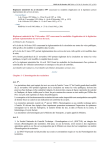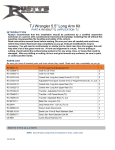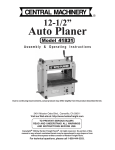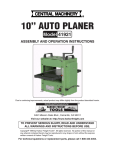Download Delta 46-715 Owner`s manual
Transcript
OWNER’S MANUAL RING MASTER® For the DELTA 46-715 14" Wood Lathe Cat. No. 744 CAUTION - Read important safety instructions AND operation instructions, BEFORE operating your RING MASTER® (CAT.NO. 744). Your new RING MASTER® is a quality-built machine, capable of dependable performance throughout its lifetime. To take full advantage of these capabilities you should thoroughly understand the proper method and technique of its operation. Therefore, we suggest you read this manual before operating and that you save it for future reference. Assembly and Operation FORM P/N 301128 (6/1/2004) RING MASTER® - DELTA 46-715 14” CAT. NO. 744 OPERATING INSTRUCTIONS PNI’s LIMITED ONE YEAR WARRANTY PNI is proud of the RING MASTER® it manufactures and warrants it to be free of defects from workmanship and material for a period of 1 year from the date of original purchase. In the unlikely event that a problem occurs, return the product to our plant freight prepaid and allowed, so that a determination of the fault can be made. If the fault is determined to be defective materials or workmanship, a no-charge replacement or repair will be made, at our discretion. The product will be returned to you freight prepaid and allowed. WARRANTY WILL BE VOID IF REPAIRS ARE MADY BY OTHER THAN FACTORY AUTHORIZED PERSONNEL AND WILL RELIEVE PNI OF FURTHER LIABILITY UNDER THE GUARANTEE. This warranty does not cover accidents, abuse or misuse and in no case will PNI be liable for incidental or consequential damages. No other warranty written or verbal is authorized. This guarantee ends one year after date of original purchase. PNI reserves the right to change or modify the design and/or specifications of Ring Master at any time without prior notice to any user. Returns for warranty service or repair must have a RMA number prior to returning; contact Customer Service at 800-634-9281. Returns should be sent to: Porta-Nails, Inc. 4235 US Hwy. 421 N. Currie, NC 28435 Attention Service Dept. 2 General Safety Instructions for Power Tools 1. 2. 3. 4. 5. 6. 7. 8. 9. 10. WEAR PROPER APPAREL Do not wear loose clothing, gloves, neckties or jewelry (rings, wrist watches) that could get caught in moving parts. Wear non slip footwear. Wear protective hair covering to contain long hair. Roll long sleeves above the elbow. 11. USE SAFETY GOGGLES (Head Protection) Wear safety goggles at all times. (Must comply with ANSI Z87.1). Everyday eyeglasses have impact resistant lenses only. They are NOT safety glasses. Also, use face or dust mask if a cutting operation is dusty. Wear ear protectors (plugs or muffs) during extended periods of operation. 12. SECURE WORK Use a vise or clamps to hold work when practical. It is safer than using your hands. This will free hands allowing them to operate the tool. 13. DO NOT OVERREACH Keep proper footing and balance at all times. 14. MAINTAIN TOOLS WITH CARE Keep tools sharp and clean for best and safest performance. Follow instructions for lubricating and changing accessories. 15. DISCONNECT TOOLS Before servicing or changing accessories such as blades, bits, cutters, etc., disconnect from electrical and air supplies. 16. AVOID ACCIDENTAL STARTING Make sure switch is in "OFF" position before plugging it in. 17. NEVER LEAVE TOOL RUNNING UNATTENDED Turn power off. Do not leave tool until it comes to a complete stop. KNOW YOUR POWER TOOL Read the owner's manual carefully. Learn its applications and limitations as well as the potential hazards specific to this tool. GROUND ALL TOOLS PNI power tools are equipped with an approved 3-prong grounding type plug to fit the proper grounding type receptacle. The green conductor in the cord is the grounding wire. Never connect the green wire to a live terminal. KEEP GUARDS IN PLACE Be sure guards are in working order, and in proper adjustment and alignment. REMOVE ADJUSTING KEYS AND WRENCHES Check to see that keys and adjustment wrenches are removed from tool before turning it on. KEEP WORK AREA CLEAN Cluttered areas and benches invite accidents. Floor must not be slippery due to sawdust. AVOID DANGEROUS ENVIRONMENT Do not use power tools in damp or wet locations or expose them to rain. Keep work area well lit. Provide plenty of surrounding work space. KEEP CHILDREN AWAY All visitors should be kept a safe distance from work area. DON'T FORCE TOOL It will do the job better and safer at the rate for which it as designed. USE THE RIGHT TOOL Don't force tool or attachment to do a job it was not designed for. Additional Safety Instructions for the RING MASTER® 5. WARNING: FOR YOUR OWN SAFETY, DO NOT ATTEMPT TO OPERATE YOUR RING MASTER® UNTIL IT IS COMPLETELY ASSEMBLED AND INSTALLED ACCORDING TO THE INSTRUCTION...AND UNTIL YOU HAVE READ AND UNDERSTAND THE OWNERS MANUAL. 1. If any part of your RING MASTER® is malfunctioning, has been damaged or broken, cease operating immediately until the particular part is properly repaired or replaced. 2. Never place your fingers in a position where they could contact the cutting tool. 3. INSPECT YOUR POWER TOOL THOROUGHLY Set up your RING MASTER® according to instructions. Make sure all parts are included. 4. KEEP CUTTING TOOLS SHARP - Be sure to keep cutting tools sharp. Dull tools can cause rough cuts, tool overheating, excessive chipping and ACCIDENTS. 6. 7. SAFETY SHIELD - Though you plan to use safety glasses, do not remove the safety shield. TWO SHIELDS ARE BETTER THAN ONE, or none. FOLLOWING OPERATING INSTRUCTIONS All procedures should be followed. They have been developed to insure safe operation AND complete satisfaction with your RING MASTER®. THINK SAFETY - Carefully plan each operation before turning on tool. Plan each step through to the point when you turn motor OFF. SAFETY INSTRUCTIONS BE SURE TO FOLLOW ALL SAFETY INSTRUCTIONS BEFORE, DURING AND AFTER THE OPERATION OF YOUR RING MASTER®! 3 Assembly 1. 2. 3. Locate index plate (Item A), (1) #10-32 screw 5/8" long, with washer (Items B) and attach index plate to right end of "rod base". PLACE SCREW THROUGH SLOT in index plate. Find Polycarbonate face shield (Item C) and attach to swing plate using (3) #8-32 screws and trim washers (Item D). Find 3/16" index pin (Item E), move slide plate away from rear of machine. Loosen index plate lock screw, and insert index pin through hole in right rear of slide plate into any hole in index plate. Note, there is a small slot into which the index plate lock screw fits, slide the index plate fully to the rear and tighten the lock screw. The above procedure merely aligns the index plate hole pattern with the index pin. You will repeat this procedure each time you loosen or move the index plate. RING MASTER® SET UP INSTRUCTIONS FIGURE 1 CAUTION: Use only knot and crack free "tight grain" wood. DO NOT cut any other material. PREPARE THE WOOD FOR MOUNTING ON THE ARBOR 1. Cut wood in squares not over 11-1/2". 2. Find the center of each square and mark with a punch. 3. Using a compass, draw the largest circle possible inside the wood square. 4. Drill a 1/2" hole in the center. A 1/2" hole will permit mounting on the Arbor of the Lathe. 5. After drilling, saw corners off being careful not to saw inside the circle. See FIGURE 2. FIGURE 2 4 MOUNTING THE WOOD ON THE DELTA 46-715 14" LATHE Attach the arbor, provided, to the DELTA 46-715 Lathe. Mount the wood on the arbor and place the 15/8" cupped washer on the arbor next to the wood. Screw on the 1/2" nut and tighten using the 3/4" wrench provided. ATTACHING THE 744 RING MASTER® TO DELTA 46-715 14" LATHE 1. 2. 3. 4. 5. 6. Position the 744 RING MASTER® over lathe way bars as shown. Place the 744 RING MASTER® Assembly with Lock Bar (Item H) into middle of way bars as shown. (Note: Lock Bar is already assembled to 744 RING MASTER® assembly.) Place Clamp Bar (Item J) in way bars positioned as shown. Insert 1/2" Socket Screw (Item K) through Clamp Bar (Item J) and into threaded hole in the Lock Bar (Item H). Slide the RING MASTER® towards the Head Stock of the DELTA LATHE until the wood is directly over the center of the RING MASTER®. Tighten the 1/2" Socket Screw with a 3/8" hex wrench. DONOT OVER TIGHTEN THIS SCREW. This provides a clamping effect on the way bars to secure the 744 RING MASTER® to the DELTA lathe. If in later use the 744 RING MASTER® assembly seems loose, slightly tighten the 1/2" Socket Screw. Be sure to lock the head stock in place. PRIOR TO ANY POWER ON OF YOUR DELTA LATHE, be sure to refer to your DELTA owners manual lathe turning chapter for complete information on the correct operation of the Lathe. 25 24 23 HEAD STOCK 22 LATHE WAY BARS TAIL STOCK FIGURE 3 5 INSTALL AND ALIGN THE CUTTING TOOL The cutting tool consists of two blades, a left and a right hand blade. Install blades in proper left and right hand positions and clamp in place using locking screws and small hex wrench. Hold a steel straight edge against the blades and view from above. If the blades are not properly aligned, loosen locking screws, realign, and tighten. Check alignment periodically during operation. BE SURE no sawdust gets into the blade slot as proper alignment will not be possible. See "POSITIONING THE CUTTING BLADES" for proper blade alignment. FIGURE 4 HOW TO DETERMINE THE CUTTING ANGLE POSITIONING THE CUTTING BLADES There are two variables involved in the proper cutting angle: thickness of the wood and thickness of the cut. The index plate controls the thickness of the cut to a 5/16" increment. To calculate the cutting angle, draw a straight line vertically on a sheet of paper, place your wood on edge perpendicular to the line and draw a line on each side of the wood (See FIGURE 4). Measure 5/16" along the top line and mark point "B". Draw a line between points "A" and "B" and measure angle "X" with a protractor. This is your cutting angle for that thickness of wood. If you are cutting 3/4" wood the angle is about 22- 1/2°, and EVERY TIME YOU CUT 3/4" wood the angle will be the same. The cutting angle for 1/2" wood is about 32 ° and 3/8" about 39 1/2 °. Wood Spacing: Thickness 1/4" 5/16" 3/8" 7/16" 1/2" 9/16" 5/8" 11/16" 3/4" 13/16" 7/8" Unlock the slide lock, slide assembly forward and position cutting blades until both left and right blades will engage the wood. Locate the nearest index stop with the index pin. Unlock the index plate lock screw and move index plate to the rear, and tighten the lock screw. Lock slide lock. To adjust swing plate reference #34, loosen front slide plate lock bolt, reference #28, loosen swing plate lock bolt, reference #29. Adjust swing plate to desired angle and tighten. BY HAND, rotate wood one full revolution to insure that both left and right blades will engage wood. See FIGURE 5. If you find that the left blade will not engage the wood, unlock slide lock, remove index pin and slide forward to engage the NEXT index hole. Replace index pin and lock slide lock. Cutting Angle To Use With Index Plate 5/16" 51.1° 44.8° 39.6° 35.3° 31.8° 28.9° 26.4° 24.3° 22.5° 20.9° 19.5° 3/8" 56.3° 50.2° 45° 40.6° 36.9° 33.7° 30.9° 28.6° 26.5° 24.8° 23.2° Once the cutting angle has been calculated, align the degree setting on the swing plate with the scribe line on the slide plate. Lock the swing lock. 6 RING MASTER® OPERATING INSTRUCTIONS Now that you have set up the RING MASTER® to properly cut your rings, you are ready to begin. Remember to observe proper safety precautions when operating the RING MASTER®. Start motor, turn lead screw clockwise and advance left blade very slowly into the wood. (NOTE: When cutting, always advance the blade slowly. Should you attempt to cut too rapidly, you may experience chattering, vibration, checking of your work piece, or misalignment of the cutting blade.) Since each revolution yields 1/13" of movement, advance slowly for about six turns in 3/4" wood or until halfway through wood. Then reverse the turn and start to cut from the right side. Move slowly until you notice a change in the sound of the cutting. As the ring starts to fall off to the right, STOP the motor and clear the ring from the machine. You will have to unlock the slide lock to remove the ring. You'll note the outer shape of this first ring is octagonal and will not mate with any other ring, lay this ring aside for OTHER use. To cut the next ring adjust the blades to clear on both sides of the ring and slide forward for the next cut. Replace the index pin and lock the slide. NEVER ATTEMPT TO CUT A RING WITHOUT FIRST LOCKING THE SLIDE LOCK. Repeat the process explained above to cut your next ring. After cutting two rings, stack the small ring on top of the larger as shown in FIGURE 6. This will indicate if the cutting angle is correct. (NOTE: Having calculated and set the cutting angle on the degree scale is no guarantee that the rings will be cut with a good alignment. A good match of the rings can now be accomplished with minor adjustment of the cutting angle. If the top ring is larger at its base than the bottom ring, the angle must be decreased slightly. If the top ring is smaller at its base than the bottom ring, the angle must be increased slightly. If the rings do no match closely, adjust the angle and cut TWO more rings to check for acceptable alignment. FIGURE 5 CUTTING SPEED You may vary the R.P.M. depending on the diameter of the ring. Cut the largest 10-11" dia. rings at slow (700 R.P.M.) and raise the speed NOT TO EXCEED "C" (900 R.P.M.) for the smallest rings. Good Alignment Increase Angle For Good Alignment Decrease Angle For Good Alignment FIGURE 6 7 CHANGING THE CUTTING ANGLE TO 90 DEGREES WORKING WITH THE RINGS After you have cut a number of angle rings, you will want to cut some straight or 90 degree rings whose outside diameter will match the angle rings already cut. Leave the last of an angle cut piece on the spindle with the lock nut in place. Set the wing plate to 90 degrees and lock. Remove the index pin, slide the blade forward until the left blade just touches the left portion of the wood. See FIGURE 7. When contact is made with the wood, lock the slide lock. Unlock the index plate and slide forward until the index pin will engage the nearest hole. Lock the index plate screw. Unlock slide lock and pull cutting assembly to the rear. Remove angle cut wood and replace with a new piece of wood. You are now ready to continue with cutting straight rings. After you have cut a supply of angle and straight rings, the fun begins. FIGURE 8 illustrates the basic ways in which you can put the rings together to form different shapes. What you make, how large you make it, what wood or combinations of wood you use, and the finish you apply is all up to you. Now that you have cut rings around wood, you can create any hollow cylindrical wooded project. REMEMBER, RING MASTER® can easily DUPLICATE any project you make. A. Two identical rings for sharp outside curve or; B. Two identical rings for sharp inside curve. C. Two identical angle rings used with mating straight ring to yield a soft outside curve or; D. Two identical angle rings used with mating straight ring to yield a soft inside curve. E. A number of straight rings stacked. F. Mating angle rings, possibly all cut from the same piece of wood. FIGURE 7 FIGURE 8 CUTTING A STRAIGHT RING GLUING YOUR PROJECT The procedure to cut a straight ring is the same as cutting an angle ring. Slide the cutting blades to the wood and insure that both blades will fully engage wood. Insert index pin in nearest hole and lock slide. BY HAND, rotate wood one full revolution to insure blades will engage wood on both sides for the full circle. Start motor. Cut first from the right and then the left. As the cutting sound changes and the ring starts to move, stop the motor and clear the ring from the machine. Cut a second ring in the same manner. (The first ring will have and octagonal outer shape and can be used for projects such as clock faces, etc.) If the above instructions were followed correctly, the second straight ring will match the outside diameter of an angle ring cut earlier. If it does not match the outside diameter of and angle ring, repeat above instruction but be careful to just touch the blade to remnant of angle wood. Once you have decided on the shape of your project, it is time to glue it together. Use any furniture glue that is water soluble. Tight Bond Glue by Franklin is good. It is helpful to use a gluing jig like the one shown in FIGURE 9. It is actually a 3/8" threaded rod and a wing nut. Most projects will be glued upside down to utilize the 1/2" spindle hole found in the center ring. Start with the ring that is on the open end of the project. Lay it down flat on a piece of secured sandpaper on a flat surface. Move the ring in a circular motion on both sides of the ring to remove any splintered wood fibers to ensure the glued joints fit properly. Next, lay the ring on the gluing jig and apply glue to the top surface of the ring. Place the next ring on top and glue its top surface. Continue until the last piece with the 1/2" hole is in place. The last piece acts as a part of the clamp. Place a washer and the wing nut on the threaded rod and tighten until 8 some glue is squeezed out from between the rings. Use a damp cloth to remove any excess glue. Then loosen the clamp, check to see that the rings are still aligned as you wish, and tighten the clamp firmly. See "RECOMMENDED ACCESSORIES (Options)" for information on ordering a GLUE/CLAMPING FIXTURE. FINISHING YOUR PROJECT Once your project has been glued, and dried overnight, you may return your project back to the DELTA Lathe for sanding, detailing and finishing. Simply fit the 1/2" hole in the bottom of your project back on the arbor and tighten 1/2" nut. Your STEADY REST and LATHE KNIVES can be used in the usual way for detailing. However, only sand paper will yield a nice finish. Use you choice of finish, for a fine project. Remember, by using the RING MASTER®, you can easily duplicate any project. HAVE FUN! FIGURE 9 RECOMMENDED ACCESSORIES (Options) 1. 2. 3. 4. 5. 6. 7. CATALOG NUMBERS Replacement Cutter Blade (Double End) ............................................. 70140 Replacement Cutter Set (Double End - High Speed) ............................ 70141 1/2" Diameter Drill With 1/4" Shaft ..................................................... 70130 Glue/Clamping Fixture ..........................................................…........... 70100 1/2" Plug Cutter .........................................…......................….......…. 70160 Cutter Pre-Set Gauge .............................................................….......... 70138 Drum Sander 2 1/2" x 3" ........................................................….......... 70166 9 70166 70138 70140, 70141 70130 ADJUSTMENTS MAINTENANCE Keep your RING MASTER® clean. If compressed air is available, blow each part clean after use. Keeping the lead screw clean of saw dust is very important. End play may occur in the lead screw. If it occurs, correct the situation as follows: LEAD SCREW: Loosen set screw on handle (Reference #31) and press tool holder (Reference #23) toward handle (Reference #32). As you press handle toward tool holder tighten set screw. TROUBLE SHOOTING WARNING: For your safety, turn switch "off" and always remove plug from power source before trouble shooting. TROUBLE PROBABLE CAUSE REMEDY Chattering Cutting Feed too Fast Dull Cutter Blade Misalignment Advance Cutter Slowly Sharpen or Change Cutter Realign Cutters Excessive Chipping Feed too Fast Slow Down Cutter Darkens Cutter Dull Sharpen or Replace Cutter Excessive Vibration Base Not Clamped Clamp or Bolt Base Down Feed Screw Binding Dirt or Dust Build-up Dis-assemble - Clean Use Multipurpose Grease 10 6 15 14 5 37 35 18 10 33 18 17 2 16 36 3 4 27 3 29 20 7 13 28 9 12 25 34 32 19 8 11 30 24 19 1 21 26 1 23 22 11 31 Item No. Part No. Qt Part Description 1 2 3 4 5 6 7 8 9 10 11 12 13 14 15 16 17 18 19 20 21 22 23 24 25 26 27 28 29 30 31 32 33 34 35 36 37 301070 301443 301422 301423 301427 301442 301444 301202 301203 301204 301206 301207 301404 301440 301421 301701 301702 301784 301870 301103 301975 301956 301121 301964 301962 200724 301430 301432 301434 301302 301970 301979 301127 70140 301403 301436 301435 3 1 5 1 1 1 1 2 1 1 1 1 1 1 1 2 1 3 2 1 1 1 1 1 2 2 2 4 1 2 1 1 1 2 1 3 3 Nyloc Hex Nut ¼-20 Swing Frame Lock Screw Socket Cap Screw 10-32 Washer SAE #10 Washer USS 3/8 Knob Washer 5/8 ID 1” OD Slide Lock Rod Base Back Rod Clamp Front Rod Base Front Rod Clamp Index Plate Slide Plate Index Pin Guide Rod Hex Head Screw 3/8-16 Socket Flat Head Screw ¼-20 Socket Flat Head Screw Special 3/8-16 Crank Handle Base Bar Clamp Bar Lock Bar Slide Rod Base Socket Flat Head Screw – Special Clamping Socket Flat Head Screw 3/8-16 Thrust Washer “E” Retaining Ring Socket Set Screw 10-32 Slide Rod Tool Holder Lead Screw Swing Frame Cutter Blade Safety Shield Finish Washer Philips Head Screw 8-32 12 NOTES PO Box 1257, Wilmington, NC 28402 910-762-6334 * 800-634-9281 * FAX: 910-763-8650 www.ringmastertool.com [email protected] 13






















